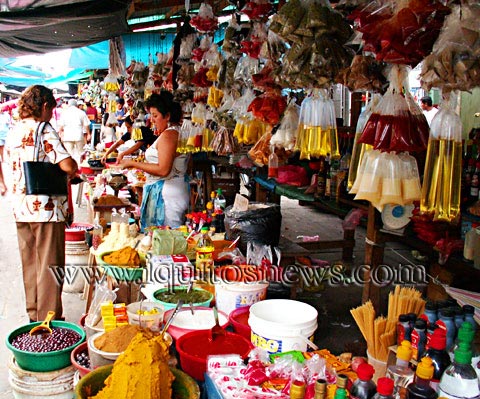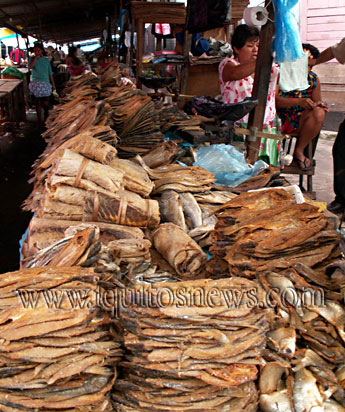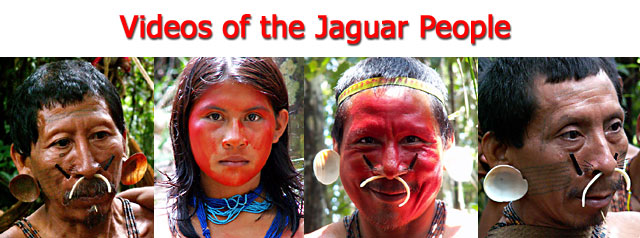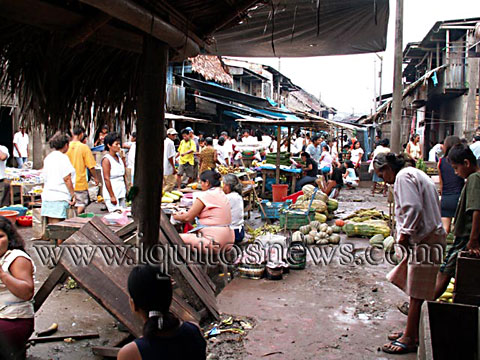tanding around a butcher’s block and suspiciously giggly, three women appeared as if they had knocked a couple back early one morning in the Belen Market. So, in true reporter style I asked one of them just how many drinks they had had. She stopped; axe poised over a chunk of black wild pig meat, hairy legs and hooves dangling over
the edge of the block and told me very seriously, “We’re not drunk, this is the happiness of being from Peru.” Though most in the market live from hand to mouth, have no health insurance and tend to rely on such cures as snake oil rubs and onion liquor concoctions, there seems to be no end to the laughter, or stories, among the stalls of the Belen Market.
 The first steps taken in the Belen Market invoke the feeling of stepping into the nozzle of a vacuum cleaner. The noise builds at the juice stands on the Calle 9 de Diciembre, then at the end of the street under the huge Belen Market sign, a corridor of women and children seated on the ground beckon you in shouting the prices of their wares. “Hay chambira, hay uvas, hay jugo de cocona a 50 centimos.” They form a narrow corridor that nudges you on, each wielding plastic bags of golf ball sized coconuts, chambira, and fruits of every variety, juices such as that of the
cocona, or guayava, and countless fistfuls of spices and condiments. The first steps taken in the Belen Market invoke the feeling of stepping into the nozzle of a vacuum cleaner. The noise builds at the juice stands on the Calle 9 de Diciembre, then at the end of the street under the huge Belen Market sign, a corridor of women and children seated on the ground beckon you in shouting the prices of their wares. “Hay chambira, hay uvas, hay jugo de cocona a 50 centimos.” They form a narrow corridor that nudges you on, each wielding plastic bags of golf ball sized coconuts, chambira, and fruits of every variety, juices such as that of the
cocona, or guayava, and countless fistfuls of spices and condiments.
The odyssey unfolds at the long rows of tables laden with dried strips of Paiche, the endangered fish that reaches the size of 3 meters, or 10 feet. Then there is the
Sapayo, a gourd that reaches the size of a child, imported by river boat from the slopes of the Andes, corn of various colors, including the purple which is a favorite for making sweet drink,
 chicha morada. Then there are turtles, pre-butchered, sometimes taken from the wild, sometimes farmed. Overflowing wheelbarrows containing onions, carrots, potatoes and bell peppers, and more varieties of fruits than even the locals can name. There, seated behind a sack of corn flour, Lilia Paima has sold imported foods in the Belen Market for over 15 years and makes just enough money to buy the next shipment of food to sell. “These beans are from Pucallpa, my Husband is there now, buying more. I stay here to sell the things he brings back.” chicha morada. Then there are turtles, pre-butchered, sometimes taken from the wild, sometimes farmed. Overflowing wheelbarrows containing onions, carrots, potatoes and bell peppers, and more varieties of fruits than even the locals can name. There, seated behind a sack of corn flour, Lilia Paima has sold imported foods in the Belen Market for over 15 years and makes just enough money to buy the next shipment of food to sell. “These beans are from Pucallpa, my Husband is there now, buying more. I stay here to sell the things he brings back.”
Consuela Ferrura sat behind a small table in the Belen Market, peeling the skins from
Aguajes. “This fruit is full of hormones, she tells me, female hormones. It’s an aphrodisiac for women, but the young boys around here eat it a lot and become homosexual. That’s why they are always turned on.” That’s just one of the many stories you will here in this market. She also sells
Caimito, an orange-sized fruit wrapped in a smooth green and yellow skin, with a sweet, juicy flesh that slides down easily, but leaves a surprise, a kind of glue that will always get a laugh with a few awkward smacks of the lips.
 Meals in the Belen Market are cheap and fried, from chicken to every kind of fish that the river has to offer, to various soups, including vegetable and cow foot (like gelatin), as well as a salty
platano mush, Tacacho, slightly crunchy and very popular. Prices range from one to two and a half Soles, sometimes with a
refresco included. Crowds squeeze between the stalls for several blocks, among offers of shoes for ten Soles, machetes for eight Soles, soccer balls, gum, shoelaces, baseball hats, neatly stacked boxes of toothpaste, flashlights, underwear and more. Pressed up against the long flights of stairs descending into Belen’s houses on stilts is a row off tobacco rollers. These men and women roll
mapacho tobacco onto thick cigarettes and cigars using a banderilla, a “little flag” which is a piece of cardboard attached to a wooden stick. Victor Gonzales paused for a moment to offer me a cigarette, and then resumed rolling faster than you could take one out of a packet and light it. “It’s strong, but after three or four puffs it becomes smoother,” he said, noting my grimace. “They’re good, a natural thing, grown here in Peru. We sprinkle them with cane liquor. The
Curanderos (the local Shamans and healers who use natural medicines) blow the smoke all over the body to get rid of evil spirits. If you have a cut on the skin, blow smoke into it to kill the bacteria and let it heal faster.” Meals in the Belen Market are cheap and fried, from chicken to every kind of fish that the river has to offer, to various soups, including vegetable and cow foot (like gelatin), as well as a salty
platano mush, Tacacho, slightly crunchy and very popular. Prices range from one to two and a half Soles, sometimes with a
refresco included. Crowds squeeze between the stalls for several blocks, among offers of shoes for ten Soles, machetes for eight Soles, soccer balls, gum, shoelaces, baseball hats, neatly stacked boxes of toothpaste, flashlights, underwear and more. Pressed up against the long flights of stairs descending into Belen’s houses on stilts is a row off tobacco rollers. These men and women roll
mapacho tobacco onto thick cigarettes and cigars using a banderilla, a “little flag” which is a piece of cardboard attached to a wooden stick. Victor Gonzales paused for a moment to offer me a cigarette, and then resumed rolling faster than you could take one out of a packet and light it. “It’s strong, but after three or four puffs it becomes smoother,” he said, noting my grimace. “They’re good, a natural thing, grown here in Peru. We sprinkle them with cane liquor. The
Curanderos (the local Shamans and healers who use natural medicines) blow the smoke all over the body to get rid of evil spirits. If you have a cut on the skin, blow smoke into it to kill the bacteria and let it heal faster.”
The market abates at the steps to Belen proper and the mood suddenly mellows. The houses below are on stilts, or Balsawood platforms that allows them to float when the river rises and floods the neighborhood.
Volleyball nets are strung between
 houses, young girls hiss for attention, people sit in doorways talking, selling drinks. Then suddenly the crowds thicken and the market resumes around the port area. At the port some
transportistas offer trips around the port in their narrow dugout canoes. Pedro Mosomit is one such boatman. He transports the locals across the river and gives tours to those who ask. “The tourists take canoes,” he said, “They don’t like to walk around here.” I took a tour, less for the fear of walking than for the enchantment of a quiet boat ride among the watery front lawns of hundreds of floating houses. Pedro paddled method-ically, slightly hunched, turning his head to chat when the mood caught him. Children played on a half-sunken boat, people sat on the ends of the logs of their floating houses, dangling their legs in the water and boats passed, full of green plantains and heavy-set women. "Over 150 native communities from upriver come down here to sell their produce in the market," he said. This put the Belen Market into perspective, the hub of every village within miles, chaotic, flavorful, practical and superstitious, thriving on and above a strip of land that is seasonally flooded. houses, young girls hiss for attention, people sit in doorways talking, selling drinks. Then suddenly the crowds thicken and the market resumes around the port area. At the port some
transportistas offer trips around the port in their narrow dugout canoes. Pedro Mosomit is one such boatman. He transports the locals across the river and gives tours to those who ask. “The tourists take canoes,” he said, “They don’t like to walk around here.” I took a tour, less for the fear of walking than for the enchantment of a quiet boat ride among the watery front lawns of hundreds of floating houses. Pedro paddled method-ically, slightly hunched, turning his head to chat when the mood caught him. Children played on a half-sunken boat, people sat on the ends of the logs of their floating houses, dangling their legs in the water and boats passed, full of green plantains and heavy-set women. "Over 150 native communities from upriver come down here to sell their produce in the market," he said. This put the Belen Market into perspective, the hub of every village within miles, chaotic, flavorful, practical and superstitious, thriving on and above a strip of land that is seasonally flooded.

|


 The first steps taken in the Belen Market invoke the feeling of stepping into the nozzle of a vacuum cleaner. The noise builds at the juice stands on the Calle 9 de Diciembre, then at the end of the street under the huge Belen Market sign, a corridor of women and children seated on the ground beckon you in shouting the prices of their wares. “Hay chambira, hay uvas, hay jugo de cocona a 50 centimos.” They form a narrow corridor that nudges you on, each wielding plastic bags of golf ball sized coconuts, chambira, and fruits of every variety, juices such as that of the
cocona, or guayava, and countless fistfuls of spices and condiments.
The first steps taken in the Belen Market invoke the feeling of stepping into the nozzle of a vacuum cleaner. The noise builds at the juice stands on the Calle 9 de Diciembre, then at the end of the street under the huge Belen Market sign, a corridor of women and children seated on the ground beckon you in shouting the prices of their wares. “Hay chambira, hay uvas, hay jugo de cocona a 50 centimos.” They form a narrow corridor that nudges you on, each wielding plastic bags of golf ball sized coconuts, chambira, and fruits of every variety, juices such as that of the
cocona, or guayava, and countless fistfuls of spices and condiments.

 Meals in the Belen Market are cheap and fried, from chicken to every kind of fish that the river has to offer, to various soups, including vegetable and cow foot (like gelatin), as well as a salty
platano mush, Tacacho, slightly crunchy and very popular. Prices range from one to two and a half Soles, sometimes with a
refresco included. Crowds squeeze between the stalls for several blocks, among offers of shoes for ten Soles, machetes for eight Soles, soccer balls, gum, shoelaces, baseball hats, neatly stacked boxes of toothpaste, flashlights, underwear and more. Pressed up against the long flights of stairs descending into Belen’s houses on stilts is a row off tobacco rollers. These men and women roll
mapacho tobacco onto thick cigarettes and cigars using a banderilla, a “little flag” which is a piece of cardboard attached to a wooden stick. Victor Gonzales paused for a moment to offer me a cigarette, and then resumed rolling faster than you could take one out of a packet and light it. “It’s strong, but after three or four puffs it becomes smoother,” he said, noting my grimace. “They’re good, a natural thing, grown here in Peru. We sprinkle them with cane liquor. The
Curanderos (the local Shamans and healers who use natural medicines) blow the smoke all over the body to get rid of evil spirits. If you have a cut on the skin, blow smoke into it to kill the bacteria and let it heal faster.”
Meals in the Belen Market are cheap and fried, from chicken to every kind of fish that the river has to offer, to various soups, including vegetable and cow foot (like gelatin), as well as a salty
platano mush, Tacacho, slightly crunchy and very popular. Prices range from one to two and a half Soles, sometimes with a
refresco included. Crowds squeeze between the stalls for several blocks, among offers of shoes for ten Soles, machetes for eight Soles, soccer balls, gum, shoelaces, baseball hats, neatly stacked boxes of toothpaste, flashlights, underwear and more. Pressed up against the long flights of stairs descending into Belen’s houses on stilts is a row off tobacco rollers. These men and women roll
mapacho tobacco onto thick cigarettes and cigars using a banderilla, a “little flag” which is a piece of cardboard attached to a wooden stick. Victor Gonzales paused for a moment to offer me a cigarette, and then resumed rolling faster than you could take one out of a packet and light it. “It’s strong, but after three or four puffs it becomes smoother,” he said, noting my grimace. “They’re good, a natural thing, grown here in Peru. We sprinkle them with cane liquor. The
Curanderos (the local Shamans and healers who use natural medicines) blow the smoke all over the body to get rid of evil spirits. If you have a cut on the skin, blow smoke into it to kill the bacteria and let it heal faster.”

